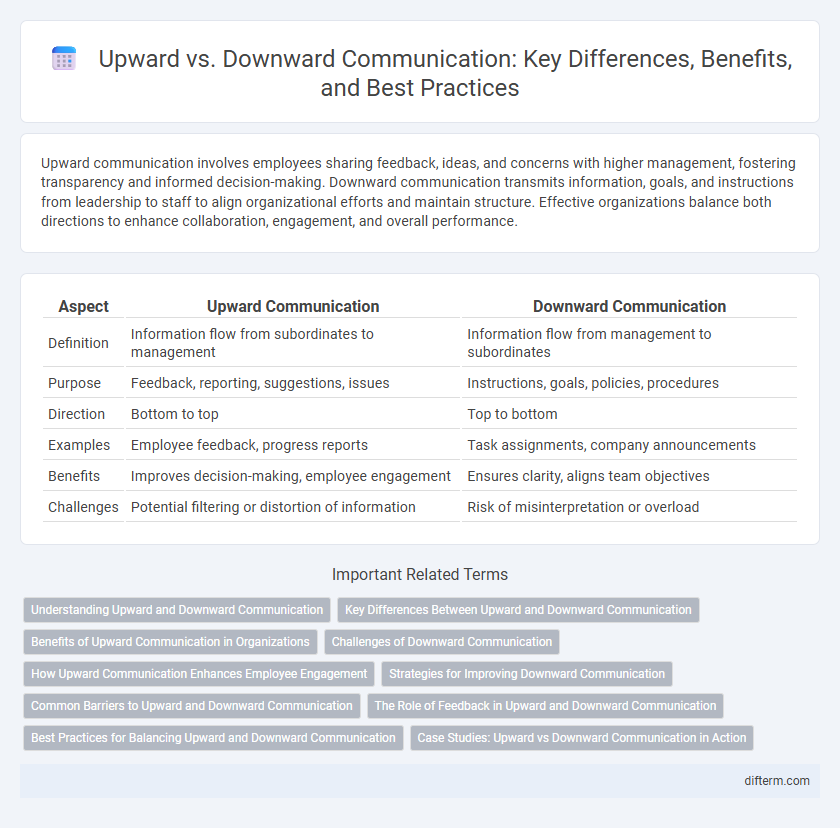Upward communication involves employees sharing feedback, ideas, and concerns with higher management, fostering transparency and informed decision-making. Downward communication transmits information, goals, and instructions from leadership to staff to align organizational efforts and maintain structure. Effective organizations balance both directions to enhance collaboration, engagement, and overall performance.
Table of Comparison
| Aspect | Upward Communication | Downward Communication |
|---|---|---|
| Definition | Information flow from subordinates to management | Information flow from management to subordinates |
| Purpose | Feedback, reporting, suggestions, issues | Instructions, goals, policies, procedures |
| Direction | Bottom to top | Top to bottom |
| Examples | Employee feedback, progress reports | Task assignments, company announcements |
| Benefits | Improves decision-making, employee engagement | Ensures clarity, aligns team objectives |
| Challenges | Potential filtering or distortion of information | Risk of misinterpretation or overload |
Understanding Upward and Downward Communication
Upward communication involves employees sharing feedback, ideas, and concerns with management, fostering transparency and informed decision-making. Downward communication transmits instructions, expectations, and organizational goals from leaders to staff, ensuring clarity and alignment within teams. Effective understanding of both channels enhances workplace collaboration and drives organizational success.
Key Differences Between Upward and Downward Communication
Upward communication involves the flow of information from subordinates to supervisors, focusing on feedback, reports, and employee concerns that aid decision-making. Downward communication transmits directives, policies, and instructions from management to employees, ensuring clarity in goals and organizational expectations. The key difference lies in their direction and purpose: upward communication centers on feedback and reporting, while downward communication emphasizes control and guidance.
Benefits of Upward Communication in Organizations
Upward communication in organizations enhances employee engagement by providing a platform for staff to share feedback and innovative ideas directly with management. This flow of information helps identify operational challenges early, enabling timely solutions and improved decision-making. Strengthening upward communication fosters a culture of transparency and trust, which boosts morale and overall organizational performance.
Challenges of Downward Communication
Downward communication often faces challenges such as message distortion, where information loses clarity as it passes through hierarchical levels, leading to misunderstandings. Employees may experience low motivation and resistance when directives lack transparency or fail to encourage feedback. Moreover, ineffective downward communication can result in decreased productivity and hinder organizational alignment.
How Upward Communication Enhances Employee Engagement
Upward communication empowers employees by providing a platform to share ideas, concerns, and feedback directly with management, fostering a sense of value and inclusion. Regular upward channels, such as surveys and suggestion boxes, enhance transparency and trust within organizations, leading to increased motivation and job satisfaction. This active exchange cultivates a collaborative work culture where employees feel heard and are more committed to organizational goals.
Strategies for Improving Downward Communication
Effective strategies for improving downward communication include clarifying messages to ensure understanding, using multiple channels such as emails, meetings, and intranet updates to reach all employees, and providing timely feedback to reinforce key points. Incorporating visual aids and simplifying language helps reduce misinterpretation and enhances message retention. Encouraging managers to practice active listening and regularly solicit employee feedback fosters a transparent and trustful communication environment.
Common Barriers to Upward and Downward Communication
Common barriers to upward and downward communication include resistance to feedback, information distortion, and hierarchical obstacles. Employees often hesitate to share honest feedback upward due to fear of negative consequences, while managers may unintentionally filter or oversimplify messages when communicating downward. Cultural differences and lack of trust further exacerbate misunderstandings, reducing overall communication effectiveness within organizations.
The Role of Feedback in Upward and Downward Communication
Feedback in upward communication enables employees to share ideas, concerns, and performance insights with management, fostering a culture of openness and continuous improvement. In downward communication, feedback ensures that messages from leadership are understood correctly and allows adjustments to be made to instructions or policies. Effective feedback loops in both directions enhance organizational alignment, employee engagement, and decision-making accuracy.
Best Practices for Balancing Upward and Downward Communication
Effective communication requires balancing upward and downward flows to enhance organizational transparency and employee engagement. Best practices include establishing regular feedback channels, encouraging open dialogue, and tailoring messages to suit different hierarchical levels while maintaining clarity. Leveraging technology tools like intranets and employee surveys optimizes the exchange of information, fostering a cohesive and responsive workplace culture.
Case Studies: Upward vs Downward Communication in Action
Case studies reveal that upward communication facilitates employee feedback, promoting innovation and problem-solving by allowing workers to share insights directly with management. Downward communication effectively disseminates organizational goals and expectations, ensuring clarity and alignment through structured messages from leaders to subordinates. Analysis of real-world examples shows that balancing both upward and downward communication enhances overall corporate communication efficiency and fosters a collaborative workplace culture.
upward vs downward Infographic

 difterm.com
difterm.com